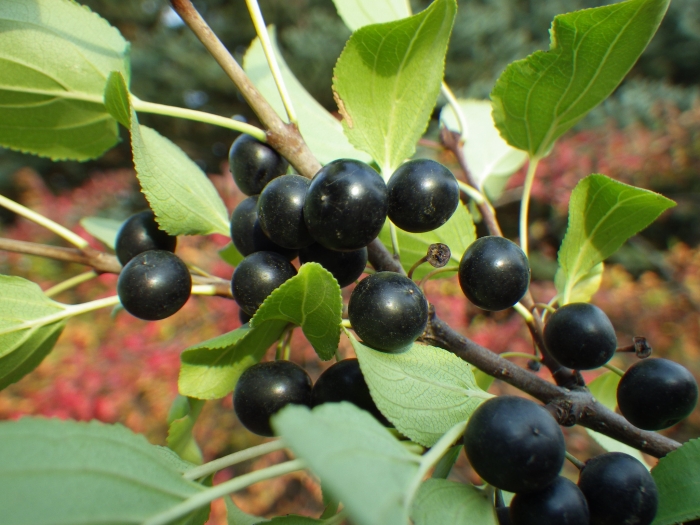Common Buckthorn
(Rhamnus cathartica)
Common Buckthorn (Rhamnus cathartica)
/
/

Matt Lavin
CC BY-SA 2.0
Image By:
Matt Lavin
Recorded By:
Copyright:
CC BY-SA 2.0
Copyright Notice:
Photo by: Matt Lavin | License Type: CC BY-SA 2.0 | License URL: https://creativecommons.org/licenses/by/2.0/ | Uploader: Matt Lavin | Publisher: Flickr |





















































Estimated Native Range
Summary
Rhamnus cathartica, commonly known as Common Buckthorn, is a deciduous shrub or small tree native to a variety of habitats including open woodlands, scrublands, and forest edges across Europe, Western Asia, and North Africa. It can grow up to 10 meters (33 ft) tall and is characterized by its grey-brown bark and often thorny branches. The leaves are elliptic to oval, measuring 25–90 mm (1–3+1⁄2 in) long and 12–35 mm (1⁄2–1+3⁄8 in) broad; they are green throughout the growing season, turning yellow in autumn. The flowers are inconspicuous, yellowish-green with four petals, and are dioecious, meaning individual plants are either male or female, and are insect-pollinated. The fruit is a small, dark berry that is attractive to birds but can be toxic to humans.
Common Buckthorn is known for its hardiness and adaptability, making it a popular choice for hedges and wildlife gardens, where it provides shelter and food for birds. However, it is also recognized for its invasive potential outside its native range, where it can form dense thickets that outcompete native vegetation. In cultivation, it thrives in full sun to part shade and is tolerant of a wide range of soil types, from slow to fast drainage. While it requires medium amounts of water, it can also withstand periods of drought once established. Gardeners should be cautious of its aggressive root system and its tendency to self-seed, which can lead to unwanted spread.CC BY-SA 4.0
Common Buckthorn is known for its hardiness and adaptability, making it a popular choice for hedges and wildlife gardens, where it provides shelter and food for birds. However, it is also recognized for its invasive potential outside its native range, where it can form dense thickets that outcompete native vegetation. In cultivation, it thrives in full sun to part shade and is tolerant of a wide range of soil types, from slow to fast drainage. While it requires medium amounts of water, it can also withstand periods of drought once established. Gardeners should be cautious of its aggressive root system and its tendency to self-seed, which can lead to unwanted spread.CC BY-SA 4.0
Plant Description
- Plant Type: Tree, Shrub
- Height: 16-25 feet
- Width: 10-15 feet
- Growth Rate: Moderate
- Flower Color: N/A
- Flowering Season: Spring, Summer
- Leaf Retention: Deciduous
Growth Requirements
- Sun: Full Sun, Part Shade
- Water: Medium
- Drainage: Slow, Medium, Fast
Common Uses
Bee Garden, Bird Garden, Salt Tolerant
Natural Habitat
Native to open woodlands, scrublands, and forest edges across Europe, Western Asia, and North Africa
Other Names
Common Names: European Buckthorn, Purging Buckthorn, Buckthorn, Vrietorn, Purgier-Kreuzdorn, Orapaatsama, Paide Bréan, Geitved, Wegedoorn, Vägtorn
Scientific Names: , Rhamnus cathartica, Rhamnus hydriensis, Rhamnus cathartica var. pubescens, Rhamnus solutina, Rhamnus cathartica var. caucasica, Rhamnus elbursensis, Rhamnus wicklia, Rhamnus cathartica subsp. hydriensis, Rhamnus cathartica var. microphylla
GBIF Accepted Name: Rhamnus cathartica L.